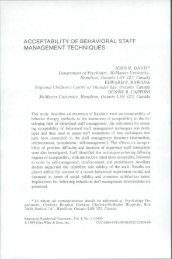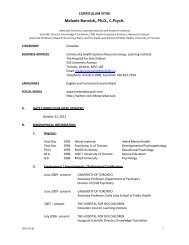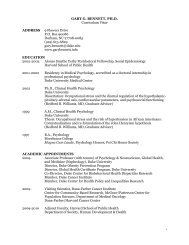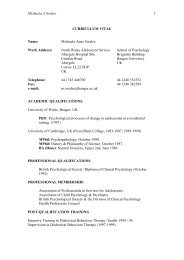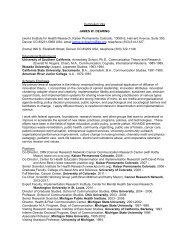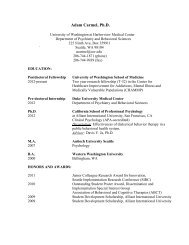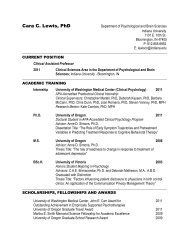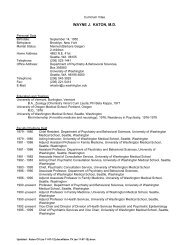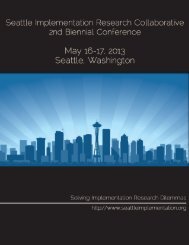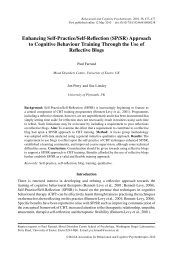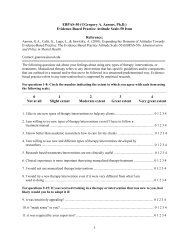The Cross-Level Effects of Culture and Climate in Human Service ...
The Cross-Level Effects of Culture and Climate in Human Service ...
The Cross-Level Effects of Culture and Climate in Human Service ...
Create successful ePaper yourself
Turn your PDF publications into a flip-book with our unique Google optimized e-Paper software.
CULTURE AND CLIMATE 771<br />
1998; Rousseau, 1985). <strong>The</strong> composition models used to aggregate data play an important role <strong>in</strong><br />
cross-level <strong>in</strong>ferences that l<strong>in</strong>k organizational climate <strong>and</strong> culture to <strong>in</strong>dividual-level outcome variables.<br />
<strong>The</strong> typology <strong>of</strong> elemental composition presented by Chan (1998) provides a useful framework<br />
for underst<strong>and</strong><strong>in</strong>g the similarities <strong>and</strong> differences <strong>in</strong> the composition <strong>of</strong> culture <strong>and</strong> climate. Elemental<br />
composition occurs when a higher-level construct is composed <strong>of</strong> a collective or aggregate <strong>of</strong> a lower<br />
level measure. It is particularly important to emphasize that organizational culture <strong>and</strong> organizational<br />
climate require different models <strong>of</strong> elemental composition. This dist<strong>in</strong>ction has not been noted previously<br />
<strong>in</strong> discussions <strong>of</strong> multilevel research on culture <strong>and</strong> climate (Kle<strong>in</strong>, Conn, Smith, & Sorra,<br />
2001).<br />
<strong>Climate</strong><br />
<strong>The</strong> appropriate composition model for climate is the direct consensus model (Chan, 1998). This<br />
model uses with<strong>in</strong>-group consensus at the lower-level (e.g., among <strong>in</strong>dividuals <strong>in</strong> a work team) as a<br />
precondition for operationaliz<strong>in</strong>g the higher-level construct (e.g., organizational climate <strong>of</strong> the work<br />
team) as an aggregate <strong>of</strong> the <strong>in</strong>dividual-level measures. In this example, a shared psychological climate<br />
at the <strong>in</strong>dividual level--represented by a value <strong>of</strong> 0.70 or above on the rwg <strong>in</strong>dex <strong>of</strong> with<strong>in</strong>-group consensus-is<br />
a prerequisite for calculat<strong>in</strong>g organizational climate as a work unit mean <strong>of</strong> the <strong>in</strong>dividual<br />
responses to a psychological climate measure (James, Demaree, & Wolf, 1984). Whether or not there<br />
is with<strong>in</strong>-group consensus, the measure <strong>of</strong> climate characterizes the <strong>in</strong>dividuals <strong>in</strong> the work unit<br />
because psychological climate is a property <strong>of</strong> the <strong>in</strong>dividual. At the same time, when there is consensus<br />
<strong>and</strong> the psychological climate is shared by members <strong>of</strong> a work unit, the aggregate composes a con-<br />
struct at the work unit level (e.g., organizational climate) although the perceptions rema<strong>in</strong> a property <strong>of</strong><br />
the <strong>in</strong>dividuals <strong>in</strong> the work unit.<br />
<strong>Culture</strong><br />
<strong>The</strong> appropriate composition model for organizational culture is the referent-shift consensus model.<br />
Unlike climate, culture is a property <strong>of</strong> the social system or work unit, not <strong>of</strong> the <strong>in</strong>dividual, <strong>and</strong> this<br />
difference is reflected <strong>in</strong> the shift <strong>in</strong> referent from the <strong>in</strong>dividual to the collective. <strong>The</strong> model is less<br />
familiar than the direct consensus model because its use is more frequently implicit than explicit<br />
(Chan, 1998). As applied to culture, the referent-shift consensus model uses <strong>in</strong>dividual responses to<br />
measure culture <strong>in</strong> work units (e.g., work teams, divisions, organizations). Referent-shift consensus<br />
composition is similar to direct consensus composition, but there is a shift <strong>in</strong> the referent prior to consensus<br />
assessment (Chan, 1998). In assess<strong>in</strong>g organizational culture us<strong>in</strong>g the referent-shift consensus<br />
model, the respondent is asked to describe the behavioral expectations <strong>and</strong> normative beliefs <strong>of</strong> people<br />
<strong>in</strong> the respondent's organizational work unit. <strong>The</strong> focus is on what the <strong>in</strong>dividual believes are the<br />
expectations <strong>and</strong> norms for the people <strong>in</strong> the respondent's work unit rather than on what the <strong>in</strong>dividual<br />
respondent th<strong>in</strong>ks is expected <strong>of</strong> him or her personally. With<strong>in</strong>-group consensus is then required to<br />
justify the aggregation <strong>of</strong> the <strong>in</strong>dividuals' beliefs about the behavioral expectations <strong>and</strong> norms with<strong>in</strong><br />
the work unit as a representation <strong>of</strong> the unit-level construct, i.e., culture. In the absence <strong>of</strong> with<strong>in</strong>-group<br />
consensus, the <strong>in</strong>dividual responses cannot be 'composed' to the unit-level construct because a lack <strong>of</strong><br />
consensus suggests that common expectations <strong>and</strong> norms have not been identified.<br />
Both the direct consensus (for climate) <strong>and</strong> referent-shift consensus (for culture) models <strong>of</strong> composition<br />
use with<strong>in</strong>-group consensus as a precondition to compos<strong>in</strong>g an <strong>in</strong>dividual-level measure to a<br />
higher-level construct. But <strong>in</strong> referent-shift consensus composition, there is a shift <strong>in</strong> the referent <strong>of</strong><br />
the lower-level attributes prior to consensus assessment. <strong>The</strong> referent is moved from the self to the<br />
collective. When culture is def<strong>in</strong>ed as the normative beliefs <strong>and</strong> behavioral expectations <strong>in</strong> the work<br />
unit, a shift <strong>in</strong> referent from the <strong>in</strong>dividual to the work unit reflects the collective nature <strong>of</strong> the construct.<br />
<strong>The</strong>re is evidence that the reword<strong>in</strong>g <strong>of</strong> items to make this shift explicit can contribute to greater<br />
Copyright ? 2002 John Wiley & Sons, Ltd. J. Organiz. Behav. 23, 767-794 (2002)




